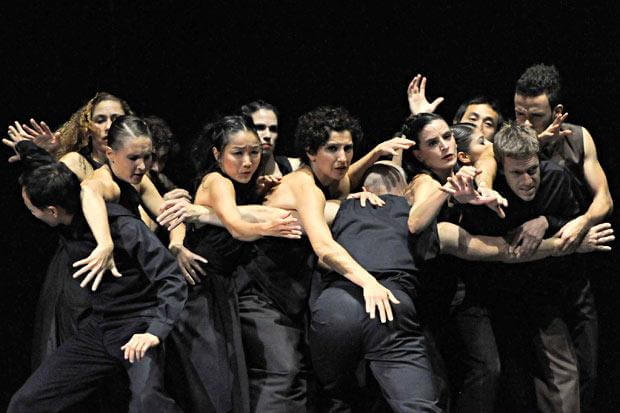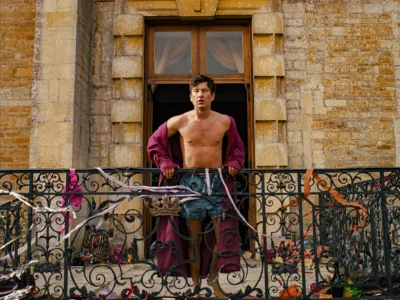Show, Don’t Tell: Continu Is a Blend of Chaos and Calm
German choreographer Sasha Waltz brought Continu to the Brooklyn Academy of Music for a short visit this past weekend, opening on Friday and closing on Saturday. While the work highlighted a large variety of Waltz’s most innovative aesthetic ideas from the last decade, the evening as a whole fell curiously flat. The audience is treated to her trademark partnering work, as intricate and seamless as ever, with haunting gestural phrases delivered by Waltz’s mature performers. However these strung-together-feats did not deliver a cohesive experience of an evening length work.
Continu opened with a stage full of women, including a drummer in the back corner. A raw emotional tone disseminated through rhythmic movement: writhing wrists, a storm of feet attacking circles. The phrase-work seemed to operate as a collection of pulsations and reactions, often grabbing at the beat with their metatarsals to trace to an undulating flick of the arm. Gestural work announced itself again and again, most interestingly with a swift cupping of the breast. The breast begins to work as a cavity, as an open space within. Amid all this, the drummer is wildly doing her job, slicing air and pounding pavement. This opening section was the most successfully visceral part of the evening, both aesthetically and musically.
Still in black, the piece transitions to the next section, a clump of men and women upstage, heads hanging low. The melodrama of loud, cinematic music drops into the space, inaugurating the weighted runs and frantic reaches of a dance “about something.” Clumps of bodies crawl at the walls, building to a frenzy of warrior-like gestures- the arrow, the fist, the gun. Both the phrase-work and spacial configurations explore the tension between the individual and the group, as some type of “horror” is taking place. While at times intentionally comedic and decidedly melodramatic, this section generally circled around a confused performativity. For example, a dancer’s hand grasping at the distance: we did not experience that particular dancer’s grasp, but the grasp as the idea of itself- not a grasp but a “grasp.”
This movement in the “black” sections was outward and emotionally demonstrative, punctuating the space with strong gestural phrase-work and detailed partnering. Similarly raw, the opera house stage was stripped down to black floors and walls. However, as the dancers enter for the third and final section, the stage was transformed to a white-scape, with both the dancers and the floor draped in white. Insular and contemplative, a series of solos, trios and larger groups appear and disappear to perform seemingly isolated movement ideas. The contrast of the black sections (fleshy and emotive) to the celestial tone of this post-modern white-scape seemed overly orchestrated; this dichotomy, like most dichotomies, did more telling than showing.
While the melodramatic quotation marks seemed to drop from the piece by the last section, having already watched so much “dancing,” we are untrusting, fatigued. While successfully providing contrast, this last section in white still can’t recover from the unconvincing theatrics of the dancing mob. Perhaps this is a result of this large-scale dance being derived from two prior, highly acclaimed site specific choreographic projects; one at the Neues Museum Berlin and the other at MAXXI in Rome in 2009. Continu seemed to suffer the typical problems of artistic consolidation; stark transitions, disjointed performativity, and a kind of over-coding of the original impulse petaling the work.
You might also like 





















